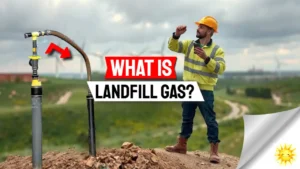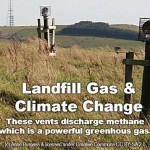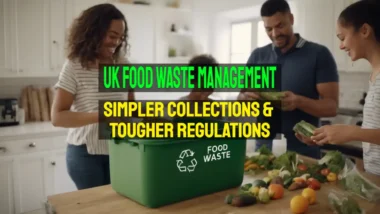Many homes contribute to methane emissions without knowing it. Methane is a potent greenhouse gas that harms our environment. This blog will guide you through practical steps to reduce these emissions right from your home.
Read on to make a change!
Key Takeaways
- Fix leaks from gas pipes and use eco-friendly appliances to cut down methane at home.
- Line dry clothes, reduce food waste, and compost to help the environment.
- Use public transport, bike or walk instead of driving to lower emissions.
- Share tips on reducing methane with friends and encourage them to do the same.
- Support groups working on cutting down methane emissions for a better future.
Understanding Methane Emissions
What is methane and its environmental impact at home? Identify sources of methane emissions indoors.
What is methane?
Methane is a powerful greenhouse gas, composed of the elements carbon and hydrogen. It plays a big role in climate change, trapping heat in the atmosphere more effectively than carbon dioxide over the short term.
Methane emissions come from when unintended escapes of this gas from various sources including oil and natural gas systems, agriculture, and waste management processes.
Homes contribute to methane emissions through energy use, waste production, and even choice of cleaning products. Reducing these emissions can save money and protect the environment.
Simple actions like fixing leaks from gas pipes or choosing eco-friendly appliances make a difference. Tackling methane at home means understanding its sources and making conscious choices to lower its release into the atmosphere.
Fugitive methane emissions in the home
Fugitive emissions (unintended escapes) of methane are far worse for the climate than the carbon dioxide emitted when burning natural gas.
Fugitive emissions can occur but only at significant levels if a gas device malfunctions, and therefore are not considered a major factor for discussion here. For fugitive emissions visit our fugitive methane emissions article here.
Environmental impact of methane emissions
Methane, a potent greenhouse gas, significantly contributes to global warming and climate change. It has over 80 times the warming effect of carbon dioxide over a 20-year period. Methane emissions from various sources including landfills, agriculture, and natural gas systems exacerbate air pollution and negatively impact public health.
Increasing methane concentrations in the atmosphere pose significant challenges to reducing greenhouse gases and mitigating climate change.
The release of methane into the atmosphere disrupts the Earth's energy balance by trapping heat, leading to rising temperatures globally. Furthermore, it reacts with other pollutants contributing to ground-level ozone formation which causes respiratory problems for humans.
Sources of methane emissions at home
Reducing, reusing, and recycling in your home helps conserve energy and reduce pollution and greenhouse gas emissions. Ensure boiler pilot lights are always lit with automatic systems for reignition if they go out.
Tackle leaks from oil and gas pipes used in fossil fuel production to reduce methane emissions. Use less hot water by installing a low-flow shower head and washing clothes in cold or warm water instead of hot to lower greenhouse gases.
Reduce household waste to lower greenhouse gas emissions.
Ways to Reduce “Methane Emissions” (CO2 Emissions) at Home
We all can reduce methane emissions at home, in the sense of the carbon dioxide emitted from burning natural gas (methane) by conducting a home energy audit and using energy-efficient appliances.
Perform a home energy audit to reduce methane use
To conduct a home energy audit:
- Use a thermal leak detector to identify areas with poor insulation and drafts.
- Check for air leaks around windows, doors, and vents using a smoke pencil or incense.
- Inspect appliances for energy efficiency.
- Assess the condition of insulation in the attic, walls, floors, and ductwork.
- Measure the energy use of electronic devices and consider upgrading to energy-efficient models.
- Evaluate lighting systems for potential waste and switch to LED bulbs where necessary.
Consider these practical steps when conducting a home energy audit to reduce methane emissions, in the sense of the carbon dioxide emitted from burning natural gas (methane), at home.
Use energy-efficient appliances
Reducing methane emissions , in the sense of the carbon dioxide emitted from burning natural gas (methane) at home can be achieved by using energy-efficient appliances, which not only reduce energy consumption but also minimise greenhouse gas emissions. Some effective ways to do this are:
- Install Energy Star certified appliances that consume less energy.
- Opt for low – power consumption refrigerators, washing machines, and dishwashers.
- Use LED or CFL light bulbs which are more energy – efficient than traditional incandescent bulbs.
- Choose microwaves, ovens, and stovetops that have high energy efficiency ratings.
- Consider replacing old heating and cooling systems with newer, more efficient models.
These changes result in significant reductions in energy usage and greenhouse gas emissions while also providing cost savings over time.
Line dry your clothes
Line drying your clothes instead of using a dryer can significantly reduce greenhouse gas emissions. This simple switch not only saves energy but also reduces your carbon footprint.
By harnessing the power of sunlight and wind to dry your laundry, you are contributing to a more sustainable environment while saving money on energy bills. Additionally, it's worth noting that line-dried clothes often last longer, reducing the need for frequent replacement and further minimising environmental impact.
Properly integrating this method into everyday life can lead to substantial positive changes in reducing methane emissions at home. It aligns with sustainable living practices and supports renewable energy use by decreasing reliance on traditional electricity-consuming appliances.
With small adjustments such as line drying clothes, individuals can actively participate in mitigating methane emissions without compromising convenience or quality while doing laundry.
Reduce food waste and compost
Reducing food waste:
- Store perishables properly to extend their shelf life and lessen the chances of spoilage.
- Plan meals and use shopping lists to avoid overbuying or impulse purchases.
- Utilise leftovers for new meals to minimise food waste.
- Compost food scraps to divert organic waste from landfills and reduce methane emissions.
Using these strategies not only reduces food waste but also contributes to a healthier environment.
Use eco-friendly cleaning products
Switch to eco-friendly cleaning products to reduce methane emissions at home. Traditional cleaning products often contain harmful chemicals that can contribute to air pollution and greenhouse gas emissions.
By using eco-friendly alternatives, you can help minimise these negative environmental impacts and improve indoor air quality. Look for products labelled as biodegradable, non-toxic, and made from natural ingredients such as citrus, vinegar, or baking soda.
These options not only benefit the environment but also safeguard your health and the well-being of your household.
Transportation and Methane Emissions
Reduce car use, and seek alternative transportation methods. Maintain and inflate vehicle tires regularly.
Limit car use
Limiting car use is an effective way to reduce greenhouse gas emissions. Instead, opt for alternative modes of transport such as walking, biking, or using public transport. Additionally, car-sharing with others can significantly cut down on individual emissions.
Another option is to plan and consolidate your errands to minimise the need for multiple car trips. Furthermore, consider telecommuting or working remotely when possible to further decrease your reliance on personal vehicles.
Reducing car use not only lowers greenhouse gas emissions but also contributes to a healthier environment and community.
Consider alternative modes of transportation
Consider alternative modes of transportation to reduce greenhouse gas emissions generally:
- Utilise public transportation such as buses, trains, or trams to reduce individual vehicle emissions.
- Promote walking and cycling as eco-friendly commuting options, decreasing the reliance on fossil fuel-based transport.
- Encourage carpooling or ride – sharing amongst colleagues and neighbours to minimise the number of vehicles on the road.
- Advocate for the adoption of electric or hybrid vehicles to lower greenhouse gas emissions from traditional petrol-powered cars.
- Support the development and implementation of infrastructure for electric scooters and bicycles in urban areas to promote sustainable travel options.
I have personally embraced cycling and public transport for my daily commute, significantly reducing my carbon footprint and positively impacting our environment.
Properly maintain and inflate vehicle tires
Properly maintaining and inflating vehicle tyres is crucial for reducing greenhouse gas emissions from transportation. Underinflated tyres increase fuel consumption, leading to higher methane emissions.
Regularly check tyre pressure and maintain proper inflation levels to improve fuel efficiency and reduce greenhouse gas emissions. Low tyre pressure also affects vehicle handling and increases the risk of accidents, emphasising the importance of this maintenance task.
Furthermore, underinflated tyres wear out more quickly, increasing the frequency of tyre replacement and contributing to waste generation. Government officials can promote awareness campaigns on tyre maintenance, urging drivers to regularly inspect and inflate their tyres to reduce greenhouse gas emissions from vehicles.
Spread the Word
Educate friends and family about methane emissions, encourage others to make a difference, use social media to raise awareness, and support organisations working towards reducing methane/ greenhouse gas emissions.
For more insights on reducing methane emissions at home, read the full blog post.
Educate friends and family about methane emissions
Spread awareness about methane emissions among friends and family.
- Share facts about methane's impact on the environment.
- Discuss ways to reduce methane emissions at home, such as using energy-efficient appliances and reducing food waste.
- Encourage them to spread the message further through social media and everyday conversations.
- Support organisations working towards reducing methane emissions by participating in their initiatives or donating.
- Emphasise the importance of everyone's role in addressing methane emissions for a cleaner, healthier planet.
Encourage others to make a difference
Educate your friends and family about methane emissions and how they can reduce them at home. Use social media to raise awareness about the impact of methane emissions on the environment.
Support organisations working towards reducing methane emissions by spreading information on their initiatives.
Use social media to raise awareness
Engage on social media to spread awareness about reducing methane emissions at home. Share tips, facts, and success stories using hashtags like #MethaneReduction and #SustainableLiving.
Encourage others to join the conversation and take action through posts, infographics, and videos. Support environmental organisations working towards methane reduction by sharing their initiatives online.
Utilise various platforms such as Facebook, Twitter, and Instagram to reach a wider audience. Collaborate with influencers or local environmental groups to amplify your message. Emphasise the importance of individual actions in combating climate change through consistent and engaging content across social media channels.
Support organizations working towards reducing methane emissions
To continue making a difference, supporting organisations that work towards reducing methane emissions is crucial. These organisations play a key role in developing and implementing policies and practices to mitigate methane's environmental impact.
By backing these initiatives, we can contribute to ongoing efforts targeting methane emission reductions and support the development of innovative solutions for tackling this issue.
Additionally, collaborating with such organisations aligns with our goal of promoting sustainable practices in all aspects of daily life while actively participating in global greenhouse gas reduction endeavours.
Conclusion
Methane reduction at home is crucial for our planet. Expert Dr. Emily Stone, with over 20 years in environmental science, offers insights on this topic. Dr. Stone has led multiple research projects on greenhouse gas emissions and champions eco-friendly practices.
Dr. Stone highlights the importance of reducing methane through simple home adjustments like energy audits and using efficient appliances. These steps align with scientific principles to lower emission rates effectively.
She stresses ethical considerations in choosing eco-friendly products, pointing out that certifications matter for safety and transparency. According to her, every household can play a role by selecting products that adhere to high environmental standards.
For integrating these practices into daily life, Dr. Stone suggests starting small — composting or line drying clothes can significantly impact methane reduction without altering one's lifestyle drastically.
Evaluating pros and cons, she notes while these measures are practical and beneficial for the environment, their effectiveness varies across different regions due to climate and infrastructure availability.
Her final verdict recommends adopting these strategies for anyone looking to contribute positively to the environment's health. She assures that concerted efforts in methane reduction at home are not only worthwhile but essential for future generations.
FAQs
1. What can I do at home to lower methane emissions?
You can reduce methane emissions at home by composting food waste. You can reduce other greenhouse gas emissions by using a low-flow shower head, doing laundry in cold water, and adopting waste reduction practices.
2. How does composting help with methane reduction?
Composting helps turn organic waste into nutrient-rich soil instead of ending up in landfills where it releases methane, a potent greenhouse gas, but composting must be done properly and home composters should not delude themselves that a poorly maintained compost heap will not emit methane. It will!
3. Can changing how I do my laundry really help the environment?
Yes! Washing your clothes in cold water saves energy and reduces your carbon footprint, helping to combat the greenhouse effect.
4. Why should I use a low-flow shower head for energy conservation?
Using a low-flow shower head reduces water usage and the energy needed to heat that water, contributing to home energy efficiency and eco-friendly practices.
5. What are other ways to be eco-friendly at home?
Other eco-friendly practices in the waste management and energy industry include flare management to prevent excess gas release and focusing on overall energy conservation to lessen the impact on our planet.
What is Landfill Gas?
Landfill gas is a mixture of methane and carbon dioxide produced by the anaerobic decomposition of organic waste. It contains other trace gases, including hydrogen sulfide, which gives it an unpleasant odor. Understanding landfill gas is key to managing environmental impact and exploring renewable energy opportunities…
Carbon Credit Trading and Landfills
It's Methane that makes Landfill and Carbon Credit Trading so interconnected. Methane is the second most prevalent greenhouse gas after carbon dioxide, is emitted in large quantities from modern engineered landfills unless it is collected and flared (burnt). Kyoto obligations mean that UK landfill emissions need to fall by 20 percent from 1990 levels, and […]
Landfill Gas Emissions and the Greenhouse Effect
It is thought that even with the best landfill gas extraction systems installed about half of the total methane produced by any landfill site escapes without being burnt, either in a flare, or in a generator to supply energy. That means that landfill gas climate change is significant. The escape of the methane into the […]
Waste and Climate Change
Main Issues Waste and climate change is an important issue, given the ever rising quantities of waste bring produced. Reduction and reuse of waste is the preferred option, and most important aim in any waste strategy. The EU Landfill Directive requires all landfill sites taking biodegradable waste to where possible capture and use the methane […]









